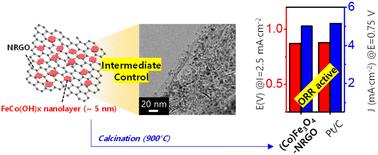当前位置:
X-MOL 学术
›
J. Mater. Chem. A
›
论文详情
Our official English website, www.x-mol.net, welcomes your
feedback! (Note: you will need to create a separate account there.)
Scalable synthesis of N-doped graphene-oxide-supported FeCo(OH)x nanosheets for efficient Co-doped Fe3O4 nanoparticle-based oxygen reduction reaction electrocatalysis
Journal of Materials Chemistry A ( IF 10.7 ) Pub Date : 2024-11-12 , DOI: 10.1039/d4ta06684g Sunglun Kwon, Jong Hyeon Lee
Journal of Materials Chemistry A ( IF 10.7 ) Pub Date : 2024-11-12 , DOI: 10.1039/d4ta06684g Sunglun Kwon, Jong Hyeon Lee

|
Developing efficient and cost-effective materials is crucial for advancing the electrochemical oxygen reduction reaction (ORR). By introducing Co2+ ions into formamide, our method prevents rapid Fe2+ oxidation to Fe3+, promoting the formation of well-defined Fe3O4 nanoparticles rather than Fe2O3. This study presents a synthesis route for high-performance spinel Fe and Co oxide nanoparticles on N-doped reduced graphene oxide (NRGO). This solvothermal synthesis in formamide yields well-dispersed, ultrafine FeCo(OH)x nanoparticles (∼5 nm) anchored on NRGO. These nanoparticles can be employed for the formation of spinel FexCo3−xO4 oxide nanoparticles, potentially due to their high surface area and strong interaction with the NRGO support. This, in turn, facilitates the successful decoration of highly dispersed spinel FexCo3−xO4 oxide nanoparticles (∼30 nm) onto the NRGO support, even after calcination at 900 °C, which represents the critical temperature for conventional graphitization. This unique approach results in significantly reduced particle aggregation compared with that of conventional methods. The (Co)Fe3O4-NRGO nanocomposite exhibits remarkable ORR activity, achieving an electron number of ∼3.7 and a current density of 5.01 mA cm−2 at E = 0.75 VRHE, comparable to those of commercial Pt/C catalysts. Furthermore, the catalyst exhibits remarkable stability, maintaining a reducing current density that is 42% lower after 40 000 s of uninterrupted operation at 0.75 VRHE compared with a 75% reduction observed with Pt/C. This exceptional performance is attributed to the strong interaction between the (Co)Fe3O4 nanoparticles and NRGO, facilitated by the Co ion precursor during annealing.
中文翻译:

N掺杂氧化石墨烯负载的FeCo(OH)x纳米片的可扩展合成,用于高效的钴掺杂Fe3O4纳米颗粒氧还原反应电催化
开发高效且具有成本效益的材料对于推进电化学氧还原反应 (ORR) 至关重要。通过将 Co2+ 离子引入甲酰胺中,我们的方法可以防止 Fe2+ 快速氧化为 Fe3+,促进形成定义明确的 Fe3O4 纳米颗粒,而不是 Fe2O3。本研究提出了一种在 N 掺杂还原氧化石墨烯 (NRGO) 上制备高性能尖晶石 Fe 和 Co 氧化物纳米颗粒的路线。这种在甲酰胺中的溶剂热合成产生锚定在 NRGO 上的分散良好的超细 FeCo(OH)x 纳米颗粒 (∼5 nm)。这些纳米颗粒可用于形成尖晶石 FexCo3−xO4 氧化物纳米颗粒,这可能是因为它们的高表面积和与 NRGO 载体的强相互作用。反过来,这又有助于将高度分散的尖晶石 FexCo3−xO4 氧化物纳米颗粒 (∼30 nm) 成功装饰到 NRGO 载体上,即使在 900 °C 下煅烧后,这代表了传统石墨化的临界温度。与传统方法相比,这种独特的方法可显著减少颗粒聚集。(Co)Fe3O4-NRGO 纳米复合材料表现出显着的 ORR 活性,在 E = 0 时达到 ∼3.7 的电子数和 5.01 mA cm-2 的电流密度。75 VRHE,与商用 Pt/C 催化剂相当。此外,该催化剂表现出卓越的稳定性,在 0.75 VRHE 下不间断运行 40 000 秒后,电流密度降低 42%,而使用 Pt/C 观察到的电流密度降低 75%。这种卓越的性能归因于 (Co)Fe3O4 纳米颗粒和 NRGO 之间的强烈相互作用,在退火过程中 Co 离子前驱体的推动下。
更新日期:2024-11-12
中文翻译:

N掺杂氧化石墨烯负载的FeCo(OH)x纳米片的可扩展合成,用于高效的钴掺杂Fe3O4纳米颗粒氧还原反应电催化
开发高效且具有成本效益的材料对于推进电化学氧还原反应 (ORR) 至关重要。通过将 Co2+ 离子引入甲酰胺中,我们的方法可以防止 Fe2+ 快速氧化为 Fe3+,促进形成定义明确的 Fe3O4 纳米颗粒,而不是 Fe2O3。本研究提出了一种在 N 掺杂还原氧化石墨烯 (NRGO) 上制备高性能尖晶石 Fe 和 Co 氧化物纳米颗粒的路线。这种在甲酰胺中的溶剂热合成产生锚定在 NRGO 上的分散良好的超细 FeCo(OH)x 纳米颗粒 (∼5 nm)。这些纳米颗粒可用于形成尖晶石 FexCo3−xO4 氧化物纳米颗粒,这可能是因为它们的高表面积和与 NRGO 载体的强相互作用。反过来,这又有助于将高度分散的尖晶石 FexCo3−xO4 氧化物纳米颗粒 (∼30 nm) 成功装饰到 NRGO 载体上,即使在 900 °C 下煅烧后,这代表了传统石墨化的临界温度。与传统方法相比,这种独特的方法可显著减少颗粒聚集。(Co)Fe3O4-NRGO 纳米复合材料表现出显着的 ORR 活性,在 E = 0 时达到 ∼3.7 的电子数和 5.01 mA cm-2 的电流密度。75 VRHE,与商用 Pt/C 催化剂相当。此外,该催化剂表现出卓越的稳定性,在 0.75 VRHE 下不间断运行 40 000 秒后,电流密度降低 42%,而使用 Pt/C 观察到的电流密度降低 75%。这种卓越的性能归因于 (Co)Fe3O4 纳米颗粒和 NRGO 之间的强烈相互作用,在退火过程中 Co 离子前驱体的推动下。


















































 京公网安备 11010802027423号
京公网安备 11010802027423号